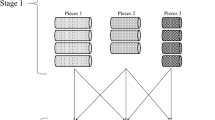Abstract
This paper addresses the one-dimensional cutting stock problem when demand is a random variable. The problem is formulated as a two-stage stochastic nonlinear program with recourse. The first stage decision variables are the number of objects to be cut according to a cutting pattern. The second stage decision variables are the number of holding or backordering items due to the decisions made in the first stage. The problem’s objective is to minimize the total expected cost incurred in both stages, due to waste and holding or backordering penalties. A Simplex-based method with column generation is proposed for solving a linear relaxation of the resulting optimization problem. The proposed method is evaluated by using two well-known measures of uncertainty effects in stochastic programming: the value of stochastic solution—VSS—and the expected value of perfect information—EVPI. The optimal two-stage solution is shown to be more effective than the alternative wait-and-see and expected value approaches, even under small variations in the parameters of the problem.
Similar content being viewed by others
References
Avriel, M., & Williams, A. C. (1970). The value of information and stochastic programming. Operations Research, 18(5), 947–954.
Axsäter, S. (2006). Inventory control. Springer’s international series. Berlin: Springer.
Bard, J. F., Morton, D. P., & Wang, Y. M. (2007). Workforce planning at USPS mail processing and distribution centers using stochastic optimization. Annals of Operations Research, 155(1), 51–78.
Belov, G., & Scheithauer, G. (2006). A branch-and-cut-and-price algorithm for one-dimensional stock cutting and two-dimensional two-stage cutting. European Journal of Operational Research, 171, 85–106.
Birge, J. R., & Louveaux, F. V. (1997). Introduction to stochastic programming. Springer series in operations research. New York: Springer.
Chauhan, S. S., Martel, A., & D’Amour, S. (2008). Roll assortment optimization in a paper mill: an integer programming approach. Computers & Operations Research, 35(2), 614–627.
Dyckhoff, H. (1990). A typology of cutting and packing problems. European Journal of Operational Research, 44(22), 145–159.
Escudero, L. F., Garín, A., Merino, M., & Pérez, G. (2007). The value of the stochastic solution in multistage problems. TOP, 15(1), 48–64.
Foerster, H., & Wäscher, G. (2000). Pattern reduction in one-dimensional cutting stock problems. International Journal of Production Research, 38(7), 1657–1676.
Gau, T., & Wäscher, G. (1995). CUTGEN1: a problem generator for the one-dimensional cutting stock problem. European Journal of Operational Research, 84(3), 572–579.
Gilmore, P. C., & Gomory, R. E. (1961). A linear programming approach to the cutting stock problem. Operations Research, 9, 848–859.
Gilmore, P. C., & Gomory, R. E. (1963). A linear programming approach to the cutting stock problem—Part II. Operations Research, 11, 863–888.
Ignizio, J. P. (1982). Linear programming in single- and multiple-objective systems. Englewood Cliffs, New Jersey: Prentice-Hall.
Kall, P., & Wallace, S. W. (1994). Stochastic programming. Chichester: Wiley.
Krichagina, E. V., Rubio, R., Taksar, M. I., & Wein, L. (1998). A dynamic stochastic stock-cutting problem. Operations Research, 46(5), 690–701.
Lasdon, L. S. (1970). Optimization theory for large systems. London: MacMillan.
Lübbecke, M. E., & Desrosiers, J. (2005). Selected topics in column generation. Operations Research, 53(6), 1007–1023.
Madansky, A. (1960). Inequalities for stochastic linear programming problems. Management Science, 6(2), 197–204.
Poldi, K. C., & Arenales, M. N. (2005). Dealing with small demand in integer cutting stock problems with limited different stock lengths. Cadernos de Computação, ICMC-USP, Série Computação, 85(6), 29–54.
Sculli, D. (1981). A stochastic cutting stock procedure: cutting rolls of insulating tape. Management Science, 27(8), 946–952.
Trkman, P., & Gradisar, M. (2007). One-dimensional cutting stock optimization in consecutive time periods. European Journal of Operational Research, 179(2), 291–301.
Wäscher, G., & Gau, T. (1996). Heuristics for the integer one-dimensional cutting stock problem: a computational study. OR Spektrum, 18(3), 131–144.
Author information
Authors and Affiliations
Corresponding author
Rights and permissions
About this article
Cite this article
Alem, D.J., Munari, P.A., Arenales, M.N. et al. On the cutting stock problem under stochastic demand. Ann Oper Res 179, 169–186 (2010). https://doi.org/10.1007/s10479-008-0454-7
Published:
Issue Date:
DOI: https://doi.org/10.1007/s10479-008-0454-7




